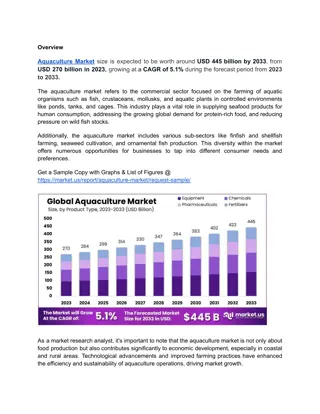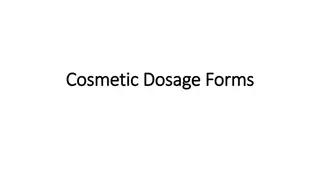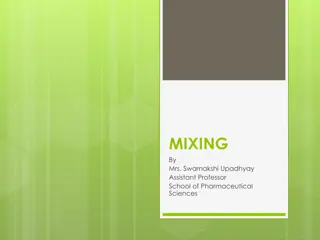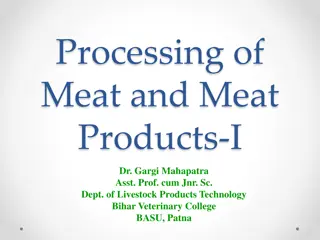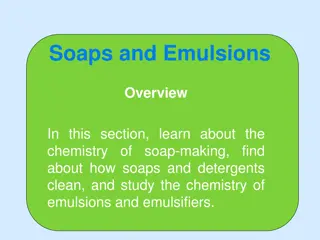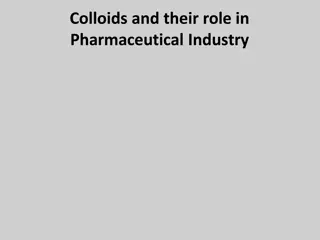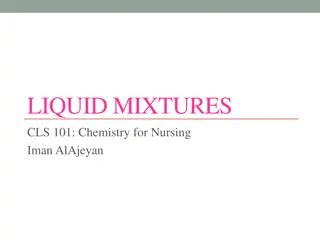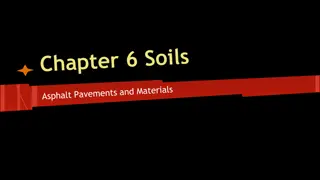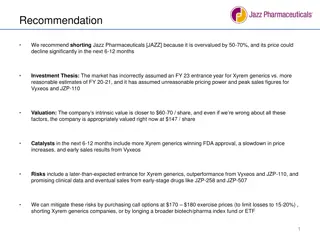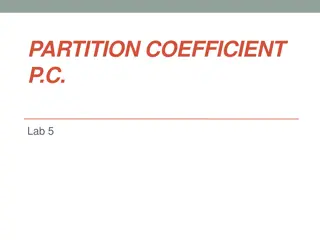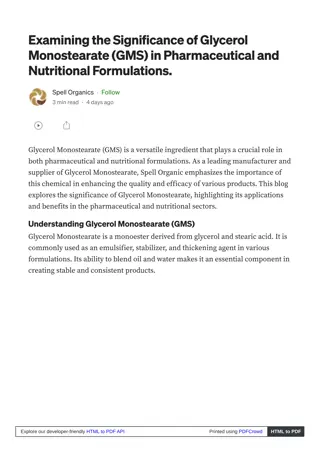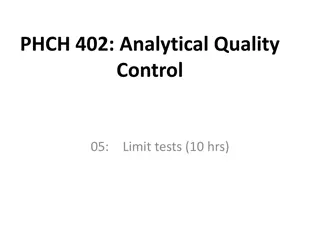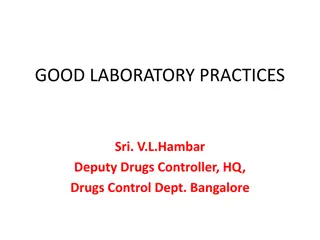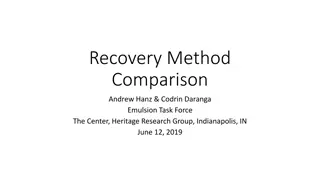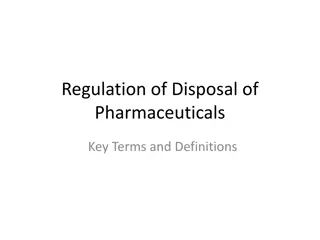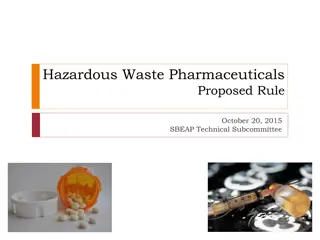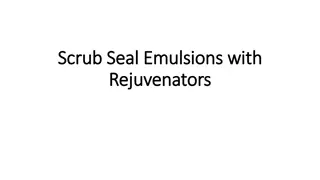Understanding Emulsions in Pharmaceuticals
Emulsions are dispersions where small liquid globules are distributed in an immiscible vehicle. While many pharmaceutical products are emulsions, some may fall into different categories. There are two main types of emulsions: oil dispersed in water (O/W) and water dispersed in oil (W/O). Factors affecting emulsion type include phase ratios, emulsifying agents, and mixing methods. Tests for identifying emulsion types include miscibility, conductivity, and staining tests. Good emulsions require clean equipment, a primary stable emulsion, suitable emulsifying agents, proper dissolution of components, and temperature control.
Download Presentation

Please find below an Image/Link to download the presentation.
The content on the website is provided AS IS for your information and personal use only. It may not be sold, licensed, or shared on other websites without obtaining consent from the author. Download presentation by click this link. If you encounter any issues during the download, it is possible that the publisher has removed the file from their server.
E N D
Presentation Transcript
EMULSIONS By : Lecturer : Ebtihal Abdul Kadhim Assist. lecturer :Zahraa Amer
EMULSIONS An emulsion is a dispersion in which the dispersed phase is composed of small globules of a liquid distributed throughout a vehicle in which it is immiscible. Many pharmaceutical actually be emulsions may not be classified as such because they fit some other pharmaceutical category more appropriately. e.g, certain liniments, creams , ointments and commercial vitamin drops. In emulsion terminology, the dispersed phase is the internal phase, and the dispersion medium is the external or continuous phase. preparations that may
TYPES OF EMULSIONS: in this type the oil droplets (internal phase) are dispersed throughout the aqueous phase (external phase) O/W emulsions in which the water (internal phase )is dispersed throughout the oil phase (external phase). W/O emulsions
FACTORS THAT AFFECT THE TYPE OF EMULSIONS : 1. The ratio of phases or relative phase volume : This means the phase in small volume will be the dispersed phase while the phase present in large volume is called the dispersion medium. But this is not a rule because sometimes the internal phase concentration may reach 74% but it is in uniform perfectly spherical droplets so it is considered as internal phase. 2. Emulsifying agent (EA) : It is very important to keep emulsion stability . Most of emulsifying agents prefer one type of emulsion , like acacia prefer o/w emulsion. 3. Order of mixing or method of preparation. Note : The type of emulsion depend on the solubility of EA in the external phase.
TESTS FOR IDENTIFICATION OF EMULSION TYPE: 1. Miscibility test: In this test the emulsion is mixed with a liquid that is miscible with the continuous phase. e.g . Dilution of emulsion with water, if no destruction occur ,this indicates its o/w ,while if destruction occurs, this means the emulsion is w/o. 2. Conductivity test: Emulsions with aqueous continuous phase will readily conduct electricity ,while emulsions with oily continuous phase will not . 3. Staining test: In this test we use water soluble dye .If the continuous phase is colored , this means that the emulsion is o/w emulsion.
REQUIREMENT FOR GOOD EMULSION: 1. All equipment used must be clean and dry. 2. Aprimary emulsion should be prepared first, which is thick , stable emulsion. 3. Asuitable emulsifying agent should be chosen. 4. All water soluble components should be dissolved in part of water forming an aqueous phase .Also all oil soluble components should dissolve in oil phase. 5. If there is any waxy material warmed and the temperature of the aqueous phase SHOULD be 2-3 C above that of the oily phase to prevent crystallization of the waxy material which will affect the stability of the emulsion. or semisolid surfactant, the phases should be Additive like strong electrolytes may affect the stability of emulsion so these should be added after finishing the primary emulsion to prevent interaction with the emulsifying agent
Calculation of primary emulsions: The amount of the emulsifying agent needed for preparation of primary emulsion depend on the type and the amount of the oil present in the prescription. E.A Ratio of Oil :Water :E.A. Fixed oil except liquid Volatile oil and liquid petrolatum and linseed oil petrolatum and linseed oil 3:2:1 or Acacia 4:2:1 2:2:1 Tragacanth 40:20:1 30:20:1 or 20:20:1
Notes: If more than one oil is to be incorporated, the quantity of E.A for each is calculated separately and the sum of quantities used.
Examples of volatile and fixed oils : Volatile Fixed oils Type of oil oils(essential oils) no Turpentine oil Castor oil 1 Clove oil Lard oil 2 Camphor oil Olive oil 3 Caraway oil Almond oil 4 Menthol Cod liver oil 5 Anethol Theobroma oil 6 Orange oil Cotton seed oil 7 Anise oil Linseed oil 8 Lemon oil Maize oil 9 Rose oil Sesame oil 10 Cinnamon oil Sunflower oil 11 Nutmeg oil 12 Thyme 13 Peppermint oil 14 Sandal wood oil 15 Terebene 16
RX1 Castor oil 20 ml Acacia Q.S. Water Q.S. 40 ml Calaculations : Oil= 20 ml Water= 2/4 *20= 10 ml Acacia= 1/4 *20 = 5 g
METHODSOFPREPARATIONOFEMULSIONS: Dry gum method Wet gum method Nascent soap method Electrical method (Using electrical homogenizers)
DRYGUMMETHOD : 1. Measure the oil in a dry measuring cylinder. 2. Triturate the oil with acacia powder in a dry mortar. 3. Measure water for primary emulsion and immediately add all of the water and stir continuously and vigorously (in the same direction) until the mixture thickens and the primary emulsion is formed .This is characterized by crackling sound. 4. Gradually dilute the primary emulsion with small volumes of the vehicle. 5. Gradually add any other ingredients. 6. Transfer to a measuring cylinder and make up to a final volume with the vehicle.
WETGUMMETHOD : 1. Water is added to the acacia gum and quickly triturated until the gum dissolve , to make mucilage. 2. Oil is added to this mucilage in small portions drop by drop , triturating the mixture thoroughly after each addition (in the same direction) until a thick primary emulsion is obtained. 3. Gradually dilute the primary emulsion with small volumes of the vehicle . 4. Gradually add any other ingredient. 5. Transfer to a measuring cylinder and make up to final volume with the vehicle.
DIFFERENCESBETWEENWETANDDRYGUM METHOD: Emulsifying agent is mixed with the oil in dry gum method while it is mixed with water in wet gum method. The addition of water will be all at ONCE in dry gum method , while the oil is added drop by drop in wet method. The crackling sound is heard higher in wet method than in dry method.
NASCENTSOAPMETHOD (BOTTLEMETHOD): This method involve placing the oil phase with an equal amount of alkali solution(NaOH, KOH, Mg(OH)2 ) in a suitable bottle that is closed firmly and mixture is shaken vigorously, a reaction takes place between the free fatty acids in oil and alkali solution that will form the emulsifying agent which is the soap(nascent soap). Notes: Nascent soap method requires an oil rich in free fatty acids as olive oil or linseed oil. The type of emulsion produced by nascent soap method depend on the type of alkali.
TYPESOFINSTABILITYOFEMULSIONS: Coalescence and breaking( irreversible). Deterioration by microorganisms. Flocculation and creaming (reversible). Miscellaneous physical and chemical changes. Bad emulsion
RX2 Oil of turpentine f ii Purified water Q.S. f i Ft. emulsion Sig. as directed Calculations ( primary emulsion) 1 f (fluidrachm)= 4 ml 2*4= 8 ml oil of turpentine *8 = 4 g acacia Amount of water =8 ml Note :Oil of turpentine is rubefacient for muscle spasm.
RX3 Castor oil f ii Bismuth carbonate gr x Purified water Q.S. f i Ft. emulsion Sig. f ss o.n Calculations (primary emulsion) 2*4 = 8 ml of oil *8 = 2 g of acacia *8 = 4 ml of water Notes : Castor oil is used internally as cathartic and externally as emollient. Bismuth carbonate is used for mild irritant skin , duodenal ulcer. Bismuth carbonate (insoluble diffusible solid ) is added or spread on the surface of the primary emulsion with continuous trituration.
RX4 Almond oil f ii Ferric ammonium citrate gr x Water Q.S. f i Ft. emulsion Calculations (primary emulsion ) 2*4= 8ml of oil *8 =2 g acacia 1/2 *8 = 4 ml water Method : Put the acacia in dry mortar then add oil phase all at once with trituration , then add water at once with trituration , until you have a crackling sound of primary emulsion, dissolve ferric ammonium citrate in part of water to get a solution then add the remaining water or dilution (gradually also with trituration then add ferric solution gradually also with trituration) Notes : Almond oil is used as nutritive. Ferric ammonium is used for iron deficiency anemia . This prescription is used as tonic .
RX5 Oil of turpentine f i Arachis oil f i Purified water Q.S. f i Calculations (primary emulsion) 1*4= 4 ml of each oil *4 = 2 g acacia for oil of turpentine *4 = 1 g acacia for arachis oil Total amount of acacia = 3 g * 4 = 2 ml water (for arachis oil) 1*4 = 4 ml water ( for oil of turpentine ) Total amount of water = 6 ml Notes : Turpentine oil is used as emollient and counterirritant. Almond oil is used as emollient and nutrient.
RX 6 Castor oil 10 ml Oleic acid 5 ml Ca(OH)2 q.s 30 ml Ft. emulsion Procedure: Ca(OH)2+ oleic acid Ca oleate(E.A.) to prepare w/o emulsion By nascent soap method
RX7 Liquid paraffin Oleic acid Sodium hydroxide Ft. emulsion Procedure: We take 10 of liquid paraffin with 5 ml of oleic acid with 15 ml sodium hydroxide in a bottle , then we shake for few seconds and an emulsion is formed . Notes: Sodium hydroxide with oleic acid leads to formation of sodium oleate (soap)which is the emulsifying agent and will form o/w emulsion. Liquid paraffin used internally as a laxative and externally as emollient to the skin. 10 ml 5 ml Q.S. 30 ml
CLASSIFICATIONOFEMULSIFYINGAGENTS: Naturally occurring emulsifying agents. e.g. acacia(Arabic gum), tragacanth, starch and pectin. Semisynthetic emulsifying agents .e.g. methylcellulose and carboxy methylcellulose . Synthetic emulsifying agents (surfactants) Anionic surfactants , e.g. sodium lauryl sulfate , sodium stearate and calcium oleate. Cationic surfactants, e.g. cetrimide and benzylkonium chloride. Amphoteric surfactants, e.g. polysorbate (tweens) and sorbitan esters(spans) Non ionic surfactants,e.g. polysorbate( tweens) and sorbitan esters (spans) 4. Finally divided solids . e.g. Bentonite , magnesium hydroxide and aluminum .Magnesium silicate.
CONCENTRATED PEPPERMINTEMULSION RX8 Peppermint oil 20 ml Polysorbate 20(tween 20) 1ml Double strength chloroform water 500 ml Purified water Q.s. 1000 ml Ft. emulsion M.ft. 50 ml Procedure: Shake the peppermint oil with polysorbate 20 Gradually add double strength chloroform water and shake well after each addition. Add sufficient water to produce 1000 ml.
HLB SYSTEM: The most important property for the effective emulsifying agent is to undergo strong adsorption at the interface between oil and aqueous phase. This requires a good balance between the hydrophilic and hydrophobic properties in the molecule and this value is called the (HLB value). The HLB value has been expressed as numerical scale that extends from (1 to 50) but practically the values are taken from (1 to 18). Notes:
REQUIRED HLB: Is the HLB that must be provided by emulsifying agent to produce a stable emulsion for a specific oil and each oil has two required HLB once for w/o and for o/w emulsion. The required HLB value may vary according to : Source of the material . Required concentration. Method of preparation.
RX9 Mineral oil 25 g E.A. (span 80+ tween 80) 2 g Preservative 0.2 g Purified water q.s. 100 g The required HLB for the mineral oil = 11 and the HLB for span 80 = 4.3 and the HLB for tween 80 = 15 How much span 80 and tween 80 required to produce a stable emulsion ? FS * HLB s + FT * HLB T = required HLB of the oil Let fraction of span =X Let fraction of tween = 1-X X*4.3 + (1-X)*15 = 11 10.7 X= 4 X= 0.37 fraction of span Amount of span = 2 g * 0.37 = 0.74 g 1-X = 0.63 fraction of tween Amount of tween = 2* 0.63 = 1.26 g
RX10 Petrolatum 25 g Cetyl alcohol 20 g E.A. (S+T) 2 g Preservative 0.2 g Purified water 100 g
NOTES : THEADVANTAGEOFMIXINGTHE EMULSIFYINGAGENT :
RX11 Liquid paraffin 35 g Wool fat 1 g Cetyl alcohol 1 g Emulgent 7 g Water 100 g HLB of liquid paraffin = 12 HLB of wool fat = 10 HLB of cetyl alcohol = 15 35+ 1+1= 37 g of oil phase 35/37 *100 = 94% w/w of liquid paraffin 1/37 *100 = 2.7% w/w of wool fat 1/37 *100 = 2.7% w/w of cetyl alcohol 0.94 *12 + 0.027*10 + 0.027*15 =12.1 required HLB for the oil phase HLB of span 80 = 4.3 HLB of tween 80 = 15 Suppose that the fraction of span = X Fraction of tween =1-X 4.3 *X + 15 (1-X)= 12.1 X =0.27 fraction of span 7* 0.27 =1.89 g amount of span 1-0.27 = 0.73 fraction of tween 7 *0.73 = 5.11g amount of tween
RX11 ( CONTINUE ) Procedure Mix the liquid paraffin with wool fat with cetyl alcohol and span .Heat the mixture on water bath at 70 C. Mix water and tween , heat the mixture on water bath at 75 C. Add the oil phase to water phase gradually with mixing using stirrer. Transfer to suitable bottle.

 undefined
undefined



















